Euros 2024 Matchday 2: Portugal Book Their Spot in the Round of 16 After Beating Turkiye
Portugal faced a formidable Turkiye squad that had defeated Georgia handily in their first game, after defeating Czechia in what was thought to be the decisive move in the last minute. Roberto Martinez has never committed to a consistent playing lineup or style of play. He seems to be searching for the one element lacking or the combination that will, in the coming days, turn this team into a formidable force.
This tactical analysis article will examine the strategy Martinez and his team employed, examining the tactics and variations from their previous match that enabled them to defeat Turkiye 3-0 and secure their place in the Round of 16.
Build-Up Analysis
Portugal put in an excellent attacking display, pressing for the goal from the first minute of play and not letting up until the very end. These are encouraging signals, so let’s examine how Martinez handled the Portugal onslaught, which appeared to be more potent and distinct than it was in the last game.
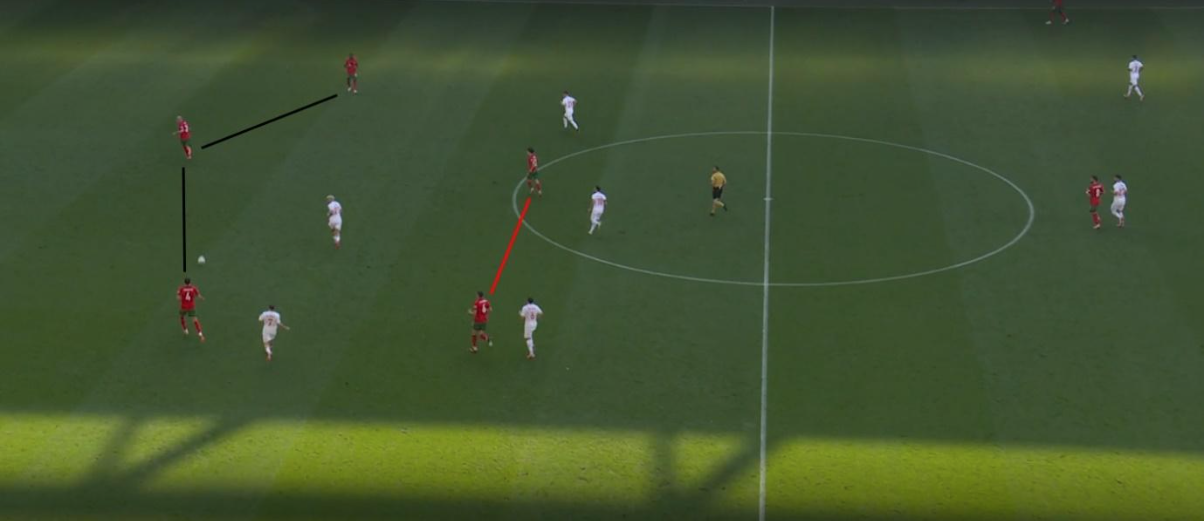
The major tactical change that contributed more to Portugal’s offense was on the defense line. Regardless of the attack style or the zone in which the game was being played, the back line was typically composed of three players. The pivots Vitinha and Joao Palhinha played supportive roles, which was the deciding factor in this back three’s productive endurance.
The pivots were essential in the game and arguably Martinez’s most significant tactical adaptation. Their parallel alignment appeared to be the ideal method for both pivots to assist the back in getting out of tight circumstances.
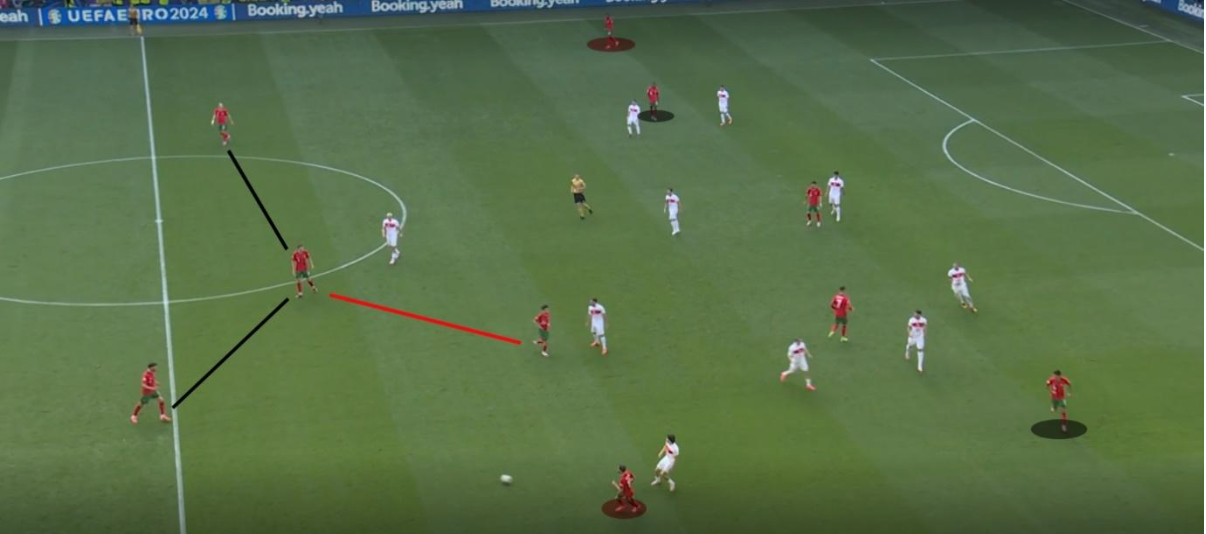
The way Portugal’s backline was assembled depended on the zones in which the ball was played. In the defensive third, for example, the back line consisted of three players with two pivots in front of them. The pivots were vital to Portugal’s offensive because, in the midfield, Palhinha, Ruben Dias, and Pepe formed the back three, while Vitinha filled the role of defensive midfielder to support the inverted fullbacks, Joao Cancelo and Nuno Mendes, to create more depth in the midfield.
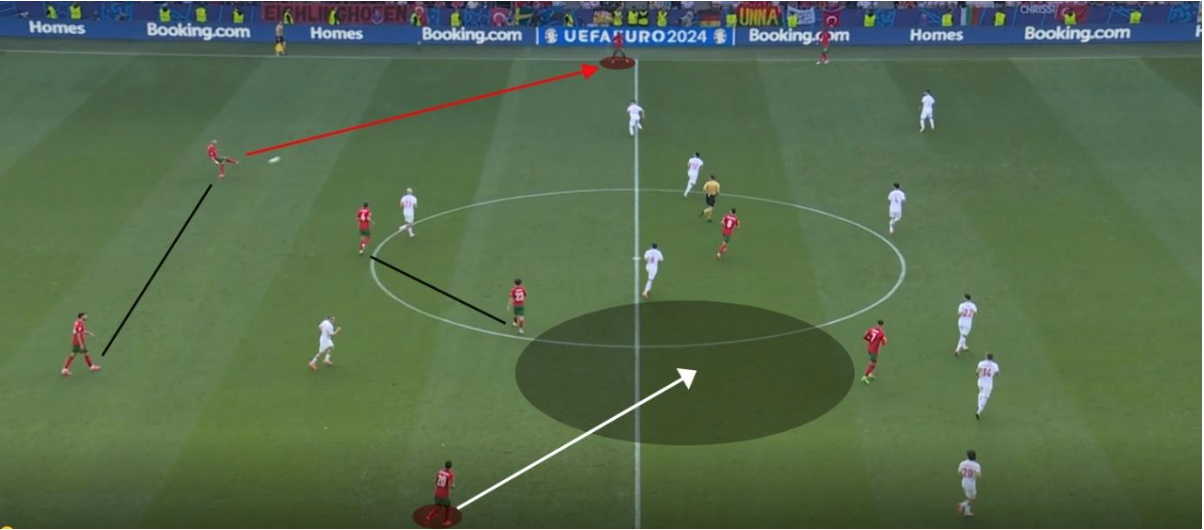
The pivots worked in tandem with Dias and Pepe to enable the team to have more players and cover ground in the midfield to create opportunities, as seen in the above image. Together with Palhinha, Dias and Pepe form a two-man defense that stays in place. Vitinha then steps forward to fill the role of defensive midfielder by aligning himself parallel to Palhinha.
This philosophy assists the fullbacks in moving the opposition and creating openings by covering ground in the midfield and on the touchline and making inverted runs. As Bernardo Silva is played as the false 9 in this game, Cancelo was used as an inverted fullback to take up the mid-field space and involve themselves in the build-up play whereas Mendes was played as an overlapping fullback or Inverted fullback based on the situation of the play.
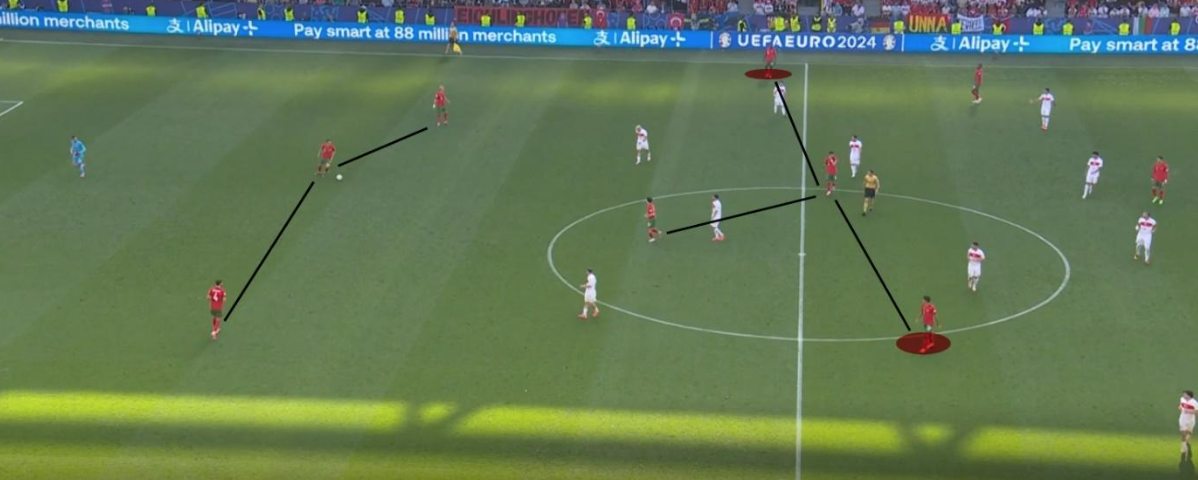
The 4-4-2 configuration allows the fullbacks to get deeper into the game; similarly, the back line consisting of Dias, Pepe, and Palhinha allows the fullback to link up with Vitinha and Fernandes to form a 3-4-3 formation. This strategic aspect in this kind of play is a major limitation from the previous game; having too few men in the midfield led to numerous issues on the attacking and defensive ends.
Bruno Fernandes played in the midfield as the false nine in the previous game, but Bernardo Silva was given the job this time and was forced to combine with the midfield to exploit the opponent’s backline. The choice to play Silva as a false 9 not only helped the team offensively but defensively as well.

Defense-wise, Turkiye is a well-organized team that pushes together, taking into account the zones to cover spaces. This allows them to press more quickly and effectively, especially when the opposition shifts play. The cornerstone of Roberto Martinez’s front-line strategy is to position two players close to the opposition’s cornerbacks to keep them centered, which encourages the opposition’s defense to create gaps when switching sides.
The front four (including the false nine) stretch the flanks with the wide two on the touchlines and the two players in the middle close to the opponent CBs, creating openings in the middle for the engine to work in instead of playing in a zone. Here the same can be seen where Dias passes to Silva and the inverted full back (Cancelo) breaks through the open space left by the corresponding wing back to break through and create higher chances of finding the goal.
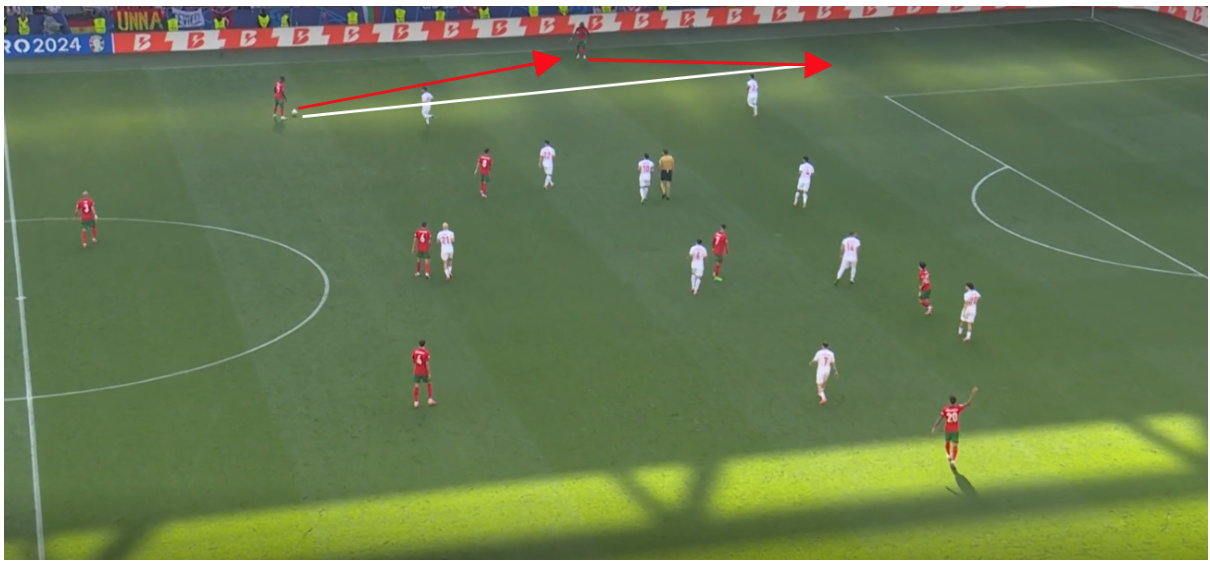
Here in this scenario, Mendes gets the ball and rotates it to Rafael Leao who is on the touchline inviting the opposition fullback which creates space for Mendes to make a run inside the box to create a more dangerous move, this is an example of the before picture explaining the ideology of the front 4 creating space and enjoying the freedom.

The amount of chances created by following the coach’s book pulled off for the Portuguese players when a deflected low cross found Bernardo Silva who was nowhere to be found in the build-up picture smashed the ball into the first post giving the goalkeeper zero chance to save. The tactical approach to put two players on the touchline and giving them the freedom to express themselves has worked brilliantly.

Portugal’s aerial prowess has been one of their greatest assets inside the box, and the players’ strategy worked flawlessly for them. Martinez substituted Palhinha for Diogo Dalot in the last game against Czechia because he was having trouble finding passes that might break the lines and give Cancelo more attacking responsibilities while also holding the defensive structure. Here, the structure play again opens up the defence as Silva keeps the ball on the touchline, allowing Cancelo to break free and find Pedro Neto at the far post, missing him by the narrowest of margins.

The plan to put two players up top with the two opposition CBs are always a threat because a single mistake from the opposition will benefit for Martinez’s men. Here the one time the CB sleeps on one player, Cancelo releases Cristiano Ronaldo who brings it down beautifully at the edge of the box before squaring it to Fernandes for a simple tap-in finish.
Defensive Analysis
The idea behind Palhinha’s substitution of Dalot was to give the extra man a more defensive role and have an attacking inverted full-back cover midfield, creating a 3-4-3 formation during defense. The defensive line and holding were intended to change positions during the attacking transition.
When the opponent was attacking, the squad formed in the traditional 4-4-2 formation but switched to a 3-4-3 during transitions. After a disorganized defensive showing in the first game, let’s examine in depth how Martinez and his team improved their defensive performance.

Portugal used a five-man defense against Czechia, with every player in the team pressing man-man in their zones regardless of the play. In order to build a 4-4-2 formation and defend with more players in the center of the field, the Portuguese players underwent a major tactical change in this match.
Despite having a similar pressing strategy, Portugal’s team was unable to move about the field and had to cover the angles instead. Portugal nearly lost their opening game because of the decision to press man-to-man regardless of the playing third. Together, Palhinha and Vitinha provided the midfield with the steadiness that was lacking.

The squad adopts a 4-3-3 shape as the ball enters the mid-3rd, with Leao positioned as the left wing’s nightguard. Leao had complete control over the attacking transition, and his only defensive task was to ensure that he stopped the additional players from joining the opposition’s build-up.
The Portuguese midfield played a totally different game as Palhinha assumed defensive leadership and kept Vitinha with him at all times. This forced Bruno or Silva to concede and helped the team play more defensively as Leao was paired with a single player and Cristiano proved to be a vital presser in preventing the ball from entering the center of the pitch.
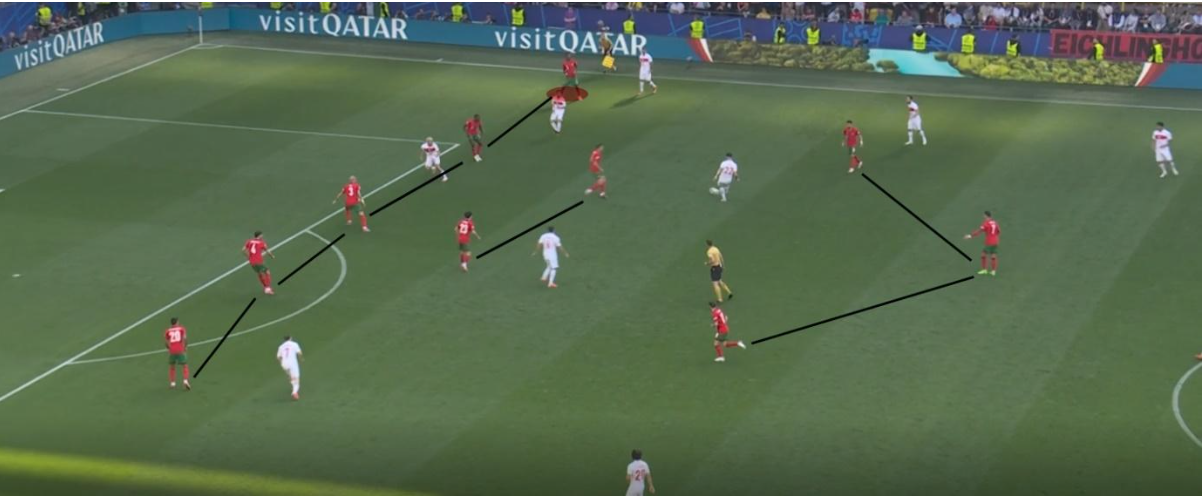
Leao joins the back four to create a five-man backline as the action enters the defensive third. The most interesting aspect is that Portugal appears to have learned from its mistakes. In the previous game, the Portuguese gave up a goal due to a lack of midfield players to disrupt or block shots.
In this game, Portugal placed two players in defensive midfielder positions directly above the penalty circle, with the other three occupying the space in front of them to close gaps that could pose a high threat. Depending on the circumstances, the 5-2-3 will frequently switch to 6-3-1, particularly if the opposition controls the play for more than a few minutes.
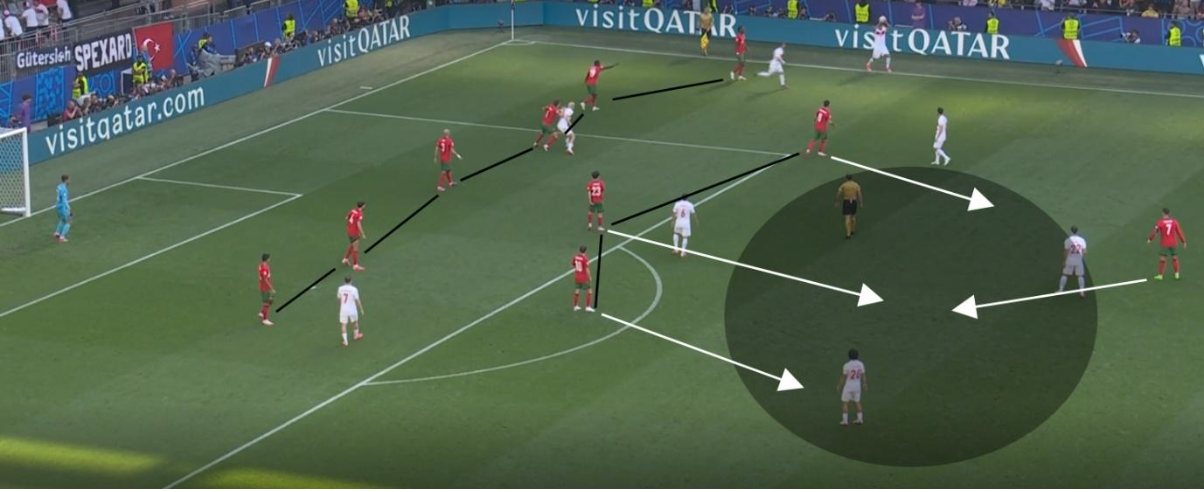
The Portugal team’s ability to maintain the advantage and exert pressure during the game is demonstrated in the shot above, when they make use of a very low block. Thanks to their manager, who skillfully worked it for the midfield to cover the dangerous space and stay in a conventional way that would help the players to move along the direction of play, Turkiye was able to hold possession for more than ten minutes without really testing the goalkeeper — except on one occasion. Portugal’s ability to remain a balanced team throughout the match was largely due to this strategy.
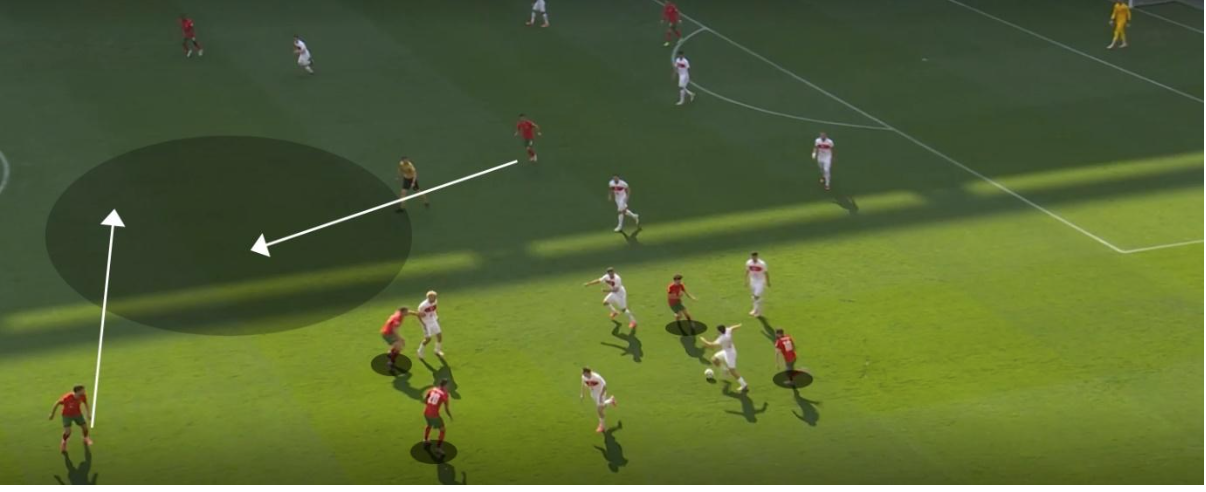
Portugal’s focus this game was on improving their defensive quality and winning the ball back as soon as possible to reduce threats and counterattacks. In the previous game, Portugal used the 4-man box strategy to invite pressure and get the opposition out of position to create more opportunities in the opposition box.
The Selecao faced about five counterattacks in the full ninety minutes, demonstrating the effectiveness of Martinez’s counter-pressing strategy, which calls for tight shutting down and having two players cover the lone opening left by the pressing four.

Another reason why this counter press worked for Martinez was because of the back three getting in shape with Vitinha in front of them. This formidable 4 have the quality, pace and physique to overcome any sort of quick counters involving 2-3 players. This was clearly possible with the way Palhinha and Vitinha shaped up in the game and never let their guard down.

This Portuguese team has been subject to Roberto Martinez’s dictates when it comes to defensive transitions. Normally, this means pressing high up the pitch (even if it takes the entire 10 minutes in the opposition half), zone pressing, or strategically pressing while playing in the third.
However, this Portugal team has been pressing man-to-man in the opposition half, with the aligned back three and defensive midfielder maintaining their shape and making appropriate movements along the zone play, and Leao playing the role of a complete lone player when it comes to defending. This is the result of combining many effective strategies for pressing teams high on the field.
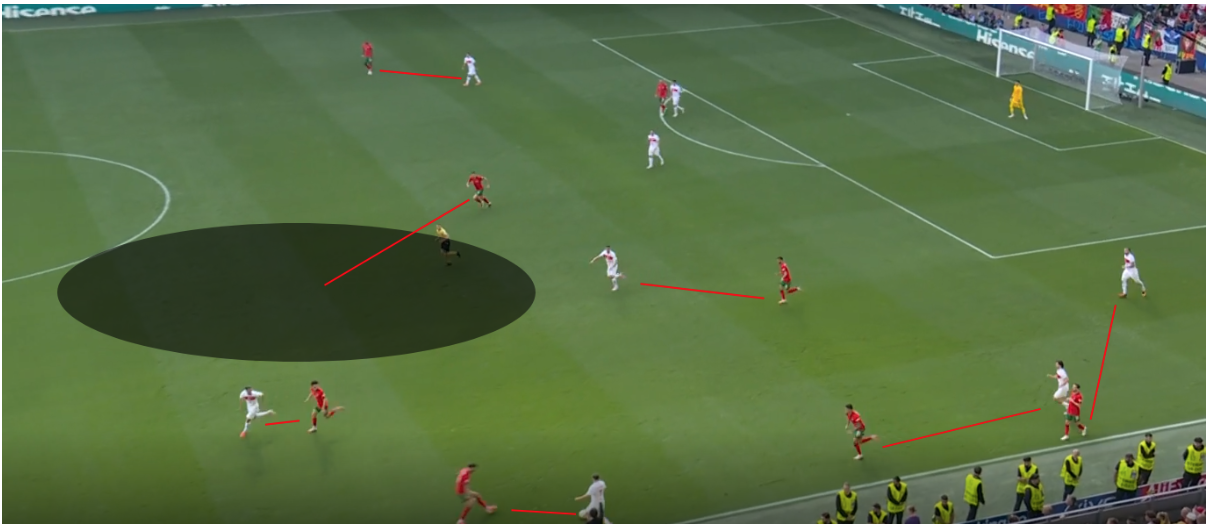
There will occasionally be periods during games when teams experience a shapeshift due to excessive excitement and lack of focus. Holding the designated midfielders in place to stop the opposition from breaking the high press and creating counters that might be very damaging and cost you the game is one such area Portugal needs to improve on.
The squad maintains man-to-man pressure in the image above, but the opponent manages to break free when Silva approaches Cancelo’s man and allows him to go free, freeing up his teammates.
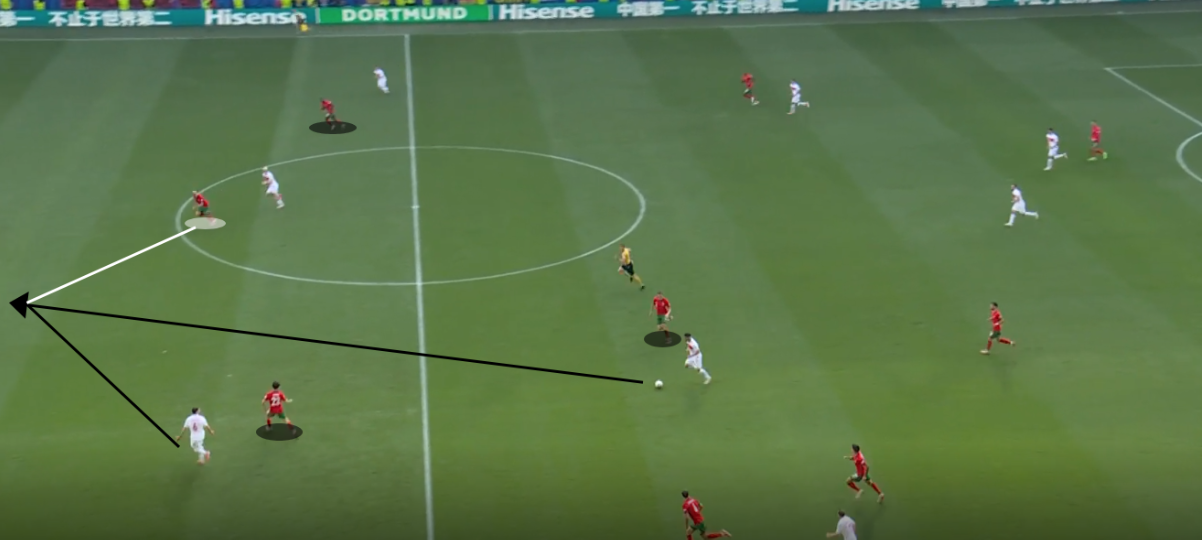
The opposition player gets the ideal ball to beat Vitinha and locate his left winger when the opponent finds an open area in the centre to create a 4 vs 3 move against Portugal. However, as the article mentions above, Pepe’s brilliance revealed why he is still such a beast at 41. Portugal would have been in a mess for the last quarter of the match if not for the perfectly timed tackle.
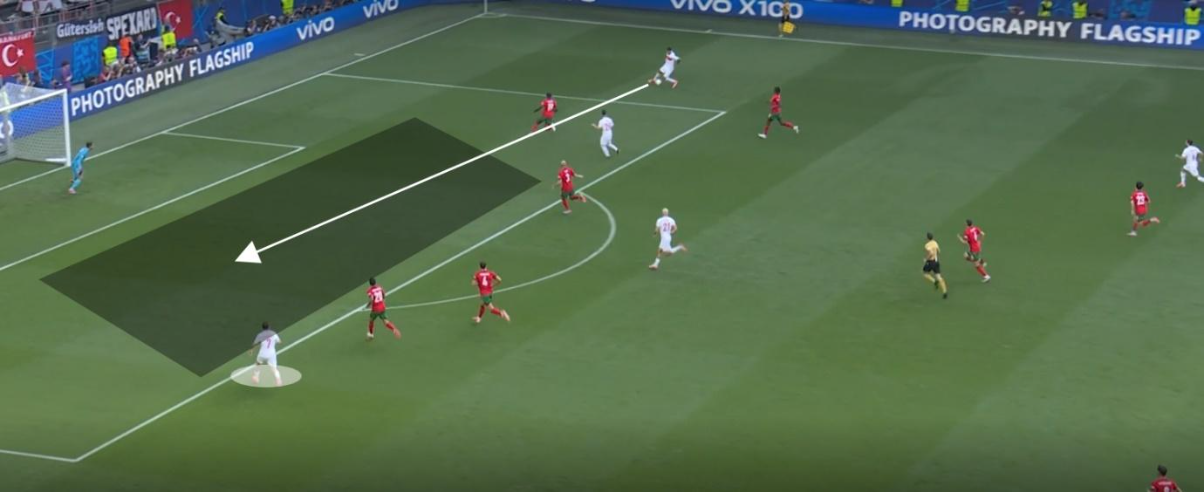
The majority of the threats in this style of play came from the wings when Portugal was being broken down on the sides with fast passes. The ineffective communication between players during player transitions caused chaos for the men in red. Turkiye’s players frequently outplayed Portugal’s defence on the touchlines, allowing them to throw accurate balls into the box.
However, Turkiye was unable to use these amazing movements because of the brilliance of this Portugal back three. Turkiye missed a great chance to level the score at the back post as Cancelo and Dias combined to save a straightforward tap-in at the far post.
Conclusion
Joao Palhinha was substituted for Diogo Dalot by Roberto Martinez, who was obviously trying to strengthen his team’s defense. Palhinha was the ideal solution to the defensive problems encountered in the first game. It was great how the back line hung on and allowed the keeper to escape. Since Palhinha and Vitinha were the game’s silent but crucial characters, Martinez needed the bridge that they created.
The offensive play was masterfully designed and carried out, and the first goal was created when Mendes and Silva, two tactical improvisers, collaborated to follow the coach’s playbook and maintain applying pressure to the opposition. The Turkish players gifted the second goal by putting the ball in their own net. Portugal’s victory was secured ten minutes into the second half by a combination of Cristiano Ronaldo and Bruno Fernandes.
Although there were several frightening moments for the Portuguese team as Turkiye nearly scored, Pepe and Dias’s experience helped Portugal stay in the game. Portugal secured their place in the next round of the event with a 3-0 victory against Turkiye on the second matchday of the competition. And whilst they fell to a 2-0 defeat to Georgia in the final group stage match, they have the chance to bounce back in fashion as they prepare to take on Slovenia in the Round of 16.
By: Sive Vishwa / @sive_vishwa
Featured Image: @GabFoligno / Gualter Fatia / Getty Images
